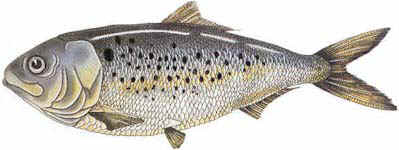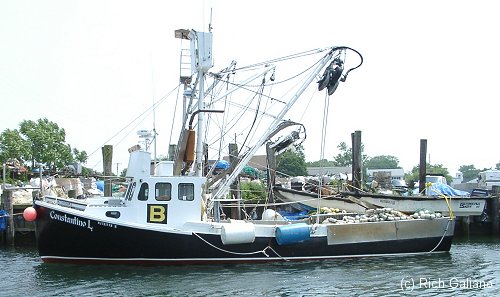Atlantic Menhaden

Scientific Name:
Brevoortia tyrannus
Atlantic Menhaden:
A Profile
Family:
Clupeidae
Size:
12"-15"
1 lb.
Common Names:
menhaden, bunker, mossbunker, pogy, fatback, alewife, bugfish, skipjack
Although this herring is generally considered unfit for human consumption, the menhaden fishery is one of the most important and productive fisheries on the Atlantic coast. For years, it has provided coastal communities with a stable source of employment and the nation with a major source of protein on a renewable and environmentally sound basis.
-- Atlantic States Marine Fisheries Commission, June 2002
Interesting Fact:
Menhaden travel in large schools which may number in the millions; this makes them easy prey for both predators and fishermen.
Identifying Features:
Very large scaleless head that occupies 1/3 of the total body length; dark blue, green, blue-gray, or blue brown above, with silvery sides, belly, and fins and a strong yellow or brassy luster; conspicuous dusky spot on each side close behind the gill opening, with a varying number of smaller dark spots farther back, arranged in irregular rows.
Life History:
Atlantic menhaden are found in estuarine and coastal waters from northern Florida to Nova Scotia and serve as prey ( food ) for many fish, sea birds, and marine mammals. Adult and juvenile menhaden form large, near-surface schools, primarily in estuaries and near-shore ocean waters from early spring through early winter. By summer, menhaden schools stratify by size and age along the coast, with older and larger menhaden found farther north. During fall through early winter, menhaden of all sizes and ages migrate south around the North Carolina capes to spawn.
Sexual maturity begins just before age three, with major spawning areas from the Carolinas to New Jersey; the majority of spawning occurs primarily offshore ( 20-30 miles ) during winter. Buoyant eggs hatch at sea, and larvae are carried into estuarine nursery areas by ocean currents. Larvae change into juveniles in estuaries where they spend most of their first year of life, migrating to the ocean in late fall. Adult and juvenile menhaden migrate south in fall-winter, and adult menhaden migrate north in spring.
One-year-old menhaden are about six inches long and weigh 2-3 ounces, three-year-old menhaden are 9-10 inches long and weigh about 0.5 pounds, and menhaden six years and older are about 1 foot long and weigh about 1 pound. Atlantic menhaden may live up to 10-12 years with a maximum length of 20 inches and three pounds.
Adult and juvenile menhaden feed by straining plankton from the water, their gill rakers forming a specialized basket to efficiently capture tiny food. Menhaden provide the link between primary production and higher organisms by consuming plankton and providing forage (food) for species such as striped bass, bluefish, and weakfish, to name just a few.
Products:
Fish caught in the purse seine reduction fishery are processed into fishmeal, fish oil, and fish solubles. Fishmeal is used as a high-quality component in poultry, swine, ruminant and aquaculture feeds, and also in pet foods. Recent technological advances have produced fishmeal that is dried after cooking at relatively low temperatures. This "low temperature" meal, when added to feed formulas, produces exceptional growth rates in target animals.

Fish oil is high in omega-3 type fatty acids which have been linked to positive health effects in humans. Partially hydrogenated fish oils are used in shortening and margarine. While these oils have been used extensively in Europe and Canada for years, partially hydrogenated menhaden oil was approved for general use by the U.S. Food and Drug Administration ( FDA ) in 1990. The FDA has recently adjusted the standard of identity for margarine to include the use of menhaden oil. The FDA is also considering approval of non-hydrogenated menhaden oil for use in selected foods. In the U.S., fish oil continues to be used in the production of water-resistant paints and cosmetics. Fish solubles are high-protein liquid by-products that are used directly in the feed market or dried onto fishmeal ( i.e., whole meal. )
Menhaden are used as bait in the commercial blue crab, lobster, crayfish, and eel fisheries. Menhaden are also used by recreational anglers as chum and as cut or live bait for sportfish such as striped bass, bluefish, king mackerel, sharks, and tunas.
Atlantic Coastal Management:
Amendment 1 to the Interstate Fishery Management Plan for Atlantic Menhaden was approved and adopted by the Commission in 2001. The plan specifies a new overfishing definition based on target mortality rates and stock biomass levels and implements a framework for future management measures as the need arises.
New Jersey Atlantic Menhaden Management:
The taking of Atlantic menhaden by any means for purposes of fishmeal reduction is prohibited in New Jersey marine waters. New Jersey allows for the licensed taking of Atlantic menhaden by purse seine for use as commercial and recreational bait outside 0.6 nautical miles from shore in Sandy Hook and Raritan Bays, the Atlantic Ocean, and Delaware Bay. Other licensed gear such as pound net; gill nets and trawls also land Atlantic menhaden for the bait market, but in very modest amounts when compared to the purse seines.
This article first appeared in New Jersey Fish & Wildlife Digest - 2003 Marine edition
April 16, 2021
The NJ Department of Environmental Protection continues to investigate large menhaden die-offs impacting the Navesink and Shrewsbury rivers of Monmouth County. These mortality events appear to be only affecting Atlantic menhaden, an extremely abundant member of the herring family primarily harvested for bait and non-food commercial purposes. Similar large-scale die-offs have been reported since the fall in coastal areas from Rhode Island to New Jersey.
Tests by the DEP's Division of Fish and Wildlife indicate that the bacterium causing these mortalities closely resembles Vibrio anguillarum, a very common bacterium found in marine environments and one of numerous Vibrio species found in those environments. The DEP continues to work to more specifically identify the species and is working with the Atlantic States Marine Fisheries Commission and other states in the region to better understand these mortalities. However, menhaden, for reasons not understood at this time, may be particularly susceptible to infection from this bacterium. The DEP is investigating whether fluctuating water temperatures, altered menhaden migration patterns or other stressors are contributing factors.
Menhaden are typically not eaten by people or fished recreationally. There is no indication that any other fish, shellfish, bird or wildlife species are being impacted by this bacterium. It is safe to continue eating other species of fish that prey on menhaden. However, it is always advised to properly cook all fish or shellfish before consuming and to never collect and consume dead fish or any that appear ill.
This bacterium is generally not known to be harmful to humans. However, contact with water in areas where fish die-offs are occurring should be avoided as a precaution. Handling of dead or unhealthy appearing fish should be avoided, including collecting for bait. If handling is necessary for disposal purposes, wear appropriate protection, including gloves.


